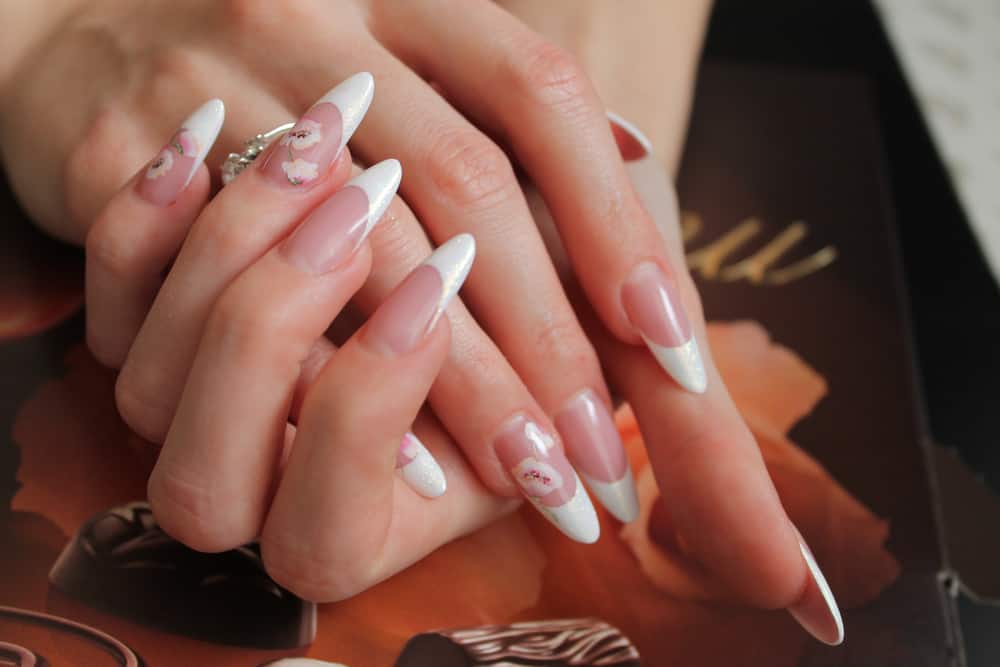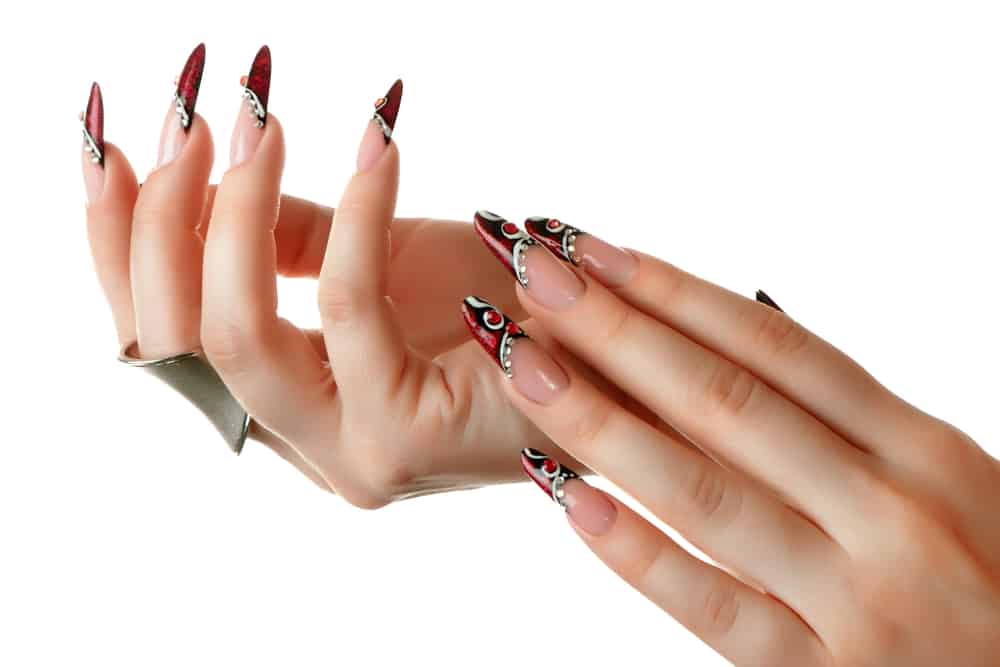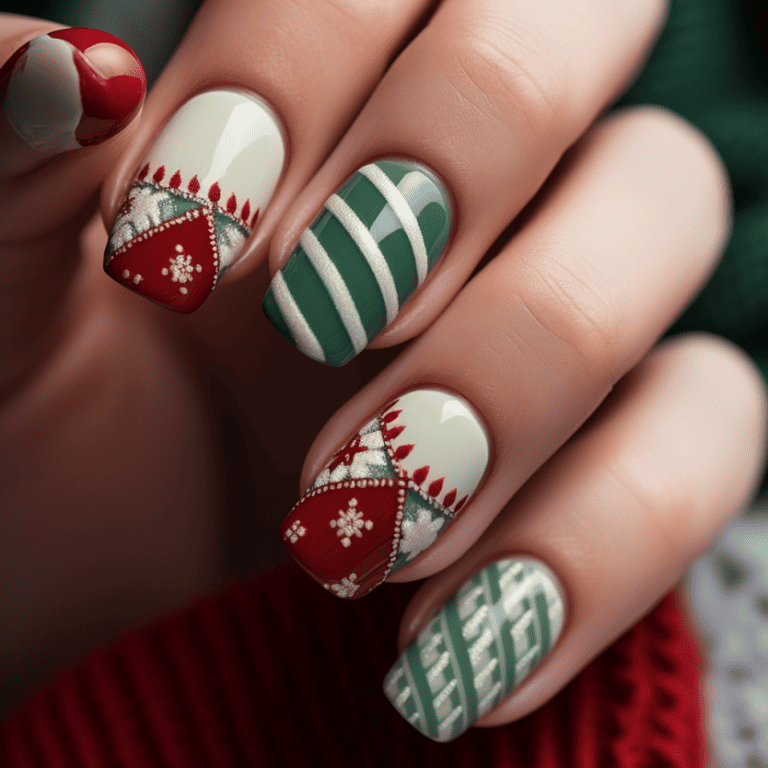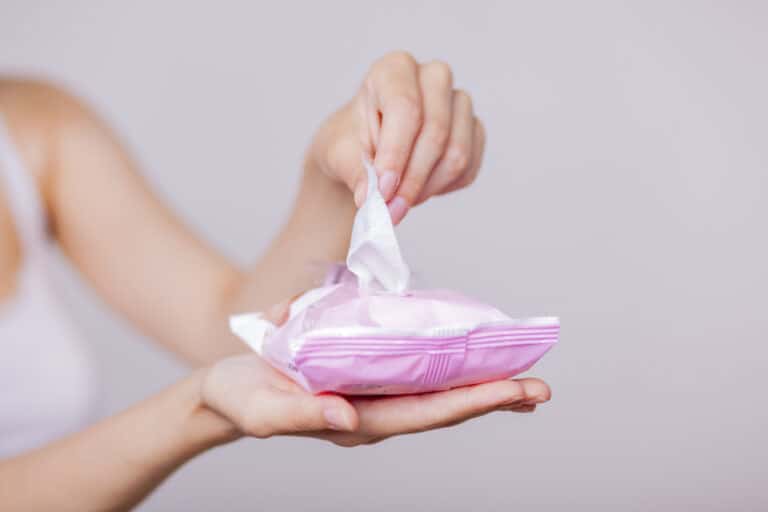Why Do My Acrylic Nails Hurt? (10 Potential Reasons)

So you came home from the nail salon excited about your new acrylics, but there is just one problem.
Your manicure has left you in a world of pain!
Let’s go through 10 potential reasons why you might be in pain after getting acrylic nails.
Better yet, we’ll walk you through a solution for each problem!
Why Do My Acrylic Nails Hurt? (10 Potential Reasons)
1. Tightening As They Dry

Acrylic nails naturally tighten as they dry.
This can cause some discomfort as your nail bed adjusts to them.
It happens most often for those who are getting acrylics for the first time or who don’t get their nails done frequently.
This is a normal part of the process and nothing to be concerned about.
As you get acrylics more often, you will get used to the shrinking of the acrylics in the beginning.
Solution:
Time.
This is just part of the process of getting acrylic nails.
The discomfort should go away within 24 hours.
If it lasts longer, go back to your nail technician.
You might need to get them removed and go for an alternative option.
2. Low-Quality Nail Glue

Not all nail glues are created equal.
There can be a lot of reasons why technicians use a certain nail glue: perhaps it is the cheapest option, the most accessible, or it’s simply the only glue they’ve ever tried.
However, just because your nail tech is using it, doesn’t necessarily mean it is a good fit for you.
If you are experiencing irritation in your nail bed after application, it might be the glue.
Some people are more sensitive to the chemicals found in certain nail glues.
Solution:
Next time you get your nails done, talk to your nail tech about different glue options.
If they don’t have any other options, or if all of the glues they use irritate your nail, consider trying a different technician.
If you try different technicians and glues but the problem persists, it may be best to take a break from your acrylic nails.
Using a press-on nail can be a good strategy to get the long nail look without having to use the chemicals found in acrylic nails and acrylic nail glue.
3. Inexperienced Nail Tech

Maybe you tried out a new nail tech to save a few bucks.
This can be a great option for getting more affordable nails, but there can be downsides.
Inexperienced nail technicians sometimes struggle with applying the right amount of pressure.
The pain from this can last for as long as a day.
An inexperienced nail tech might also file the natural nails excessively.
Filing the nail down too much can leave the nerves under your nails more exposed.
Excessive thinning of the natural nail can lead to pain.
Solution:
If your nail tech is applying too much pressure, don’t be afraid to speak up.
After all, your nail tech will benefit from improving their skill.
If they don’t take your feedback seriously, or they don’t handle it well, consider getting a new nail tech.
It’s not worth risking the health of your nails just to save a few bucks!
And in the case of a nail tech who filed your natural nail too much, it’s probably best to just steer clear of them completely in the future.
That’s a pretty serious mistake.
You don’t want to put the long-term health of your nails at risk!
4. You Broke Your Nail

Ouch—breaking a nail is never a fun experience, but it’s a million times worse when you are wearing acrylic nails.
Acrylic nails usually break as the result of some trauma inflicted on them.
Think getting jammed in a door or the nail accidentally getting hit on something.
Solution:
Remove your acrylic nails ASAP!
If the nail underneath is broken, the acrylics need to be removed so that the nail can heal properly.
You can go to your nail tech to have this done, but if you are going to do it yourself, there are some steps you need to take.
Step 1: Disinfect
Before you start the removal process, you need to thoroughly disinfect your nail.
This is especially true for the damaged area.
Wash it with antibacterial soap and warm water.
Step 2: Trim The Acrylic
You want to trim off as much of the acrylic as possible.
Ideally, if your natural nails are long enough, you will trim a small portion of your nails with acrylic.
This ensures you’ve gotten as much of the acrylic off as possible before proceeding.
Step 3: Soak The Nail
You have two main options when it comes to soaking your acrylic nails to remove them.
One option is putting your fingers into acetone for a few minutes to soften the nail.
The downside to this option is that liquid acetone can be problematic for excessively dry nails.
If your nail underneath is injured, it can also be quite painful.
Another option is to use a clean towel and a mixture of acetone and warm water.
Dip the towel into the mixture and then wrap it around your finger until the nail has sufficiently softened.
Step 4: Peel Away The Acrylic
Now that you have soaked your nail, you should be able to peel away your acrylic.
You can use tweezers to help.
Make sure you don’t use too much force.
If the nail is resisting significantly, soak them for a little longer.
After all, you don’t want to further damage your nail!
Step 5: Treat The Broken Nail
Now that your acrylic nail has been successfully removed, you should be able to assess the damage to your nail and nail bed.
There are three main tools you can use to heal your broken nail: ice, antibiotics, and pain relievers.
Applying ice to the wounded nail can help soothe it, as well as reduce pain and swelling.
For antibiotics and pain relievers, you are going to want to consult your doctor or pharmacist first.
However, using an off-the-shelf or over-the-counter pain medication can help a lot in managing the pain while it heals.
Antibiotics or antibiotic creams such as Neosporin may help accelerate the healing process and prevent infection.
5. Injury Under The Nail

The majority of times your acrylic nails are hurting, it has to do with the application of the nail.
However, in some rare instances, it is possible to sustain an injury to the finger, right under the nail.
Perhaps you were trying to clean under your nails with something sharp and nicked yourself.
Whatever the cause, if the injury is underneath the nail, you need to give it time to heal.
Solution:
Time is usually all that an injury like this needs.
Temporary pain can usually be managed by off-the-shelf painkillers.
However, if it still hurts after a few days, consult your doctor.
They will be able to tell you the best way to proceed and if it is necessary to remove your acrylic nail to aid in the healing process.
6. Incorrectly Prepared Cuticles

One essential part of any manicure is preparing the cuticles.
Your cuticles are the skin that sits along the edge of your nail, connecting it to your finger.
During the manicure, your cuticles are typically pushed back, trimmed, and conditioned.
This is an important part of applying acrylic nails because the acrylics must be attached to the actual nail and not the skin along the nail.
There are two main reasons why incorrectly prepared cuticles might be causing you pain.
The first reason cuticles may cause pain is if they were not trimmed at all.
If the nail tech attached your acrylic to the cuticle and not the nail, there is a high chance the acrylic will start separating from your finger.
This puts strain on the cuticle and can cause pain.
Solution #1:
Go to a nail tech to have the acrylics removed.
It’s probably best not to go to the same nail tech if they were applied improperly in the first place.
Even if you go back for removal, certainly don’t go back for your next set!
The second reason why incorrectly prepared cuticles might be causing you pain is if your nail tech was too aggressive in trimming or pushing them back.
If the finger or cuticle is injured during the manicure, it can not only cause pain but can also put you at risk for infection!
Solution #2:
Just like with the above case, we recommend you find a new nail tech in the future.
If your cuticle or finger was injured during the manicure, clean it with antibacterial soap.
If you continue to experience pain or see any signs of infection, go to your doctor.
7. Your Natural Nails Are Weak

Everyone is built differently.
Some people have thick and strong nails while others have nails that are thin and weak.
If you have thin or weak nails, acrylics might hurt you.
Your natural nail has to be strong enough to hold the weight of the acrylic.
If your nails are weak, they are constantly going to be strained by the acrylic.
Solution:
There are a couple of things you can do if you suffer from weak or thin nails.
Firstly, you could look into alternatives to acrylic nails.
After all, your body just might not be built to handle acrylic nails—and that is fine!
Alternatives like press-on nails or a simple gel polish manicure can still give you a polished and beautiful look.
Secondly, if you have been wearing acrylics consistently for a while, consider giving your nails a break while you let them strengthen.
Acrylic nails do damage your natural nail.
Your nail is filed down as a part of the application, and the acrylic itself is thought to be damaging.
Also, your nails are having to carry the weight of those acrylics all the time! Putting your nails through all of this regularly can significantly weaken them.
Taking a break from acrylic nails doesn’t mean that you will never be able to wear them again.
It just means that you are giving your body time to rest and recover.
If you notice your nails growing weak, take a break before you push them to their breaking point.
Thirdly, you can use nail strengthening products to increase your nail health.
There are supplements available that promote nail strength and growth.
Eating a healthier and more vitamin-rich diet is also thought to promote nail growth.
In addition to supplements you can consume, there are nail varnishes that support nail strength.
Of course, to use these you will have to remove your acrylics for a while.
After all, a strengthening nail varnish won’t do anything if it is put on top of your acrylic instead of your natural nail!
Finally, there are some home remedies that you can try.
Some people believe that olive oil or coconut oil promotes nail growth.
There’s no harm in experimenting with home remedies and seeing if they help, as long as you are using natural ingredients!
8. Allergic Reaction

There is a chance that your nail pain might be caused by an allergic reaction.
This is most likely if you are wearing acrylic nails for the first time or if you had a new product put on your nails.
Usually, an allergic reaction won’t be limited to pain.
You might also be experiencing symptoms such as:
- itching
- redness
- swelling
- irritation
If you notice your symptoms go beyond just simple pain, it’s a sign that you might be having an allergic reaction.
Solution:
If you suspect you are having an allergic reaction, it is important to immediately remove the acrylic nails.
If removing them doesn’t improve the situation or your symptoms persist, go to your doctor.
If it isn’t your first time getting acrylics, and you have gone to your normal nail tech, check with her to see if she used any new products.
And even if it is your first time, it’s still good to check what products were used so you can make sure to avoid them in the future.
9. The Shape Isn’t Ideal

That’s right, the shape of your acrylic nails can affect your comfort when wearing them.
There are two main problems you might face with nail shape:
A. Too Long
If acrylic nails are too long, they can feel quite uncomfortable.
Remember, your natural nail is having to support the weight of your acrylic nail.
Normally, your natural nail doesn’t support any weight!
The longer the acrylic is, the more weight your nail has to support.
Unless you have extremely strong nails, it might not be a good idea to get very long acrylics.
It’s not just the weight of the nail that you have to take into consideration, though.
There is also the fact that longer nails can lead to your nail incurring more trauma.
After all, if your nails are extremely long, it’s easy for them to hit objects or get stuck somewhere.
B. Pointy Tips
The point of your nails can cause problems along with the length of them.
Having acrylics with a pointy tip can result in them getting caught on more objects and materials.
Remember, whenever something catches on your acrylics, it is also pulling on your natural nail!
Solution:
This one is simple.
File them down!
If they are too long, have them cut and filed.
If they are too pointy, file them into a different, more manageable, shape.
10. Acid-Based Nail Primer

It is common to apply a nail primer before attaching the acrylic to your natural nails.
A nail primer helps ensure that the acrylics bond properly with your nail bed.
Some nail primers contain acid.
The acid helps to make tiny, invisible holes in your nail plates so that the acrylic can better bond to the nails.
Not all nail primers are acid-based, but the ones that are carry the risk of making your nails hurt.
Acid-based primers are common and many consider them safe to use.
The problem comes in when you have weak nails or when these primers are used in excess.
Solution:
Consider trying a different primer.
Talk to your nail tech about alternative options to acid-based primers.
If your nail tech doesn’t have any other options, try some other nail technicians in your area.
If you can’t find an acid-free nail primer, it might be a good idea to take a break from acrylic nails while you let your natural nails grow and heal.






